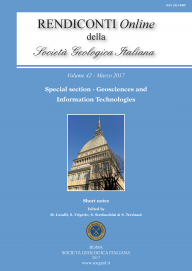
Structural inheritance controlling active crustal deformation in the Val d'Agri area (southern Apennines, Italy): new insights from finite element modelling
Antonella Megna (a), Stefano Santini (b) & Stefano Mazzoli (c)
(a) Istituto Nazionale di Geofisica e Vulcanologia (INGV), Sezione di Sismologia e Tettonofisica, via di Vigna Murata 605, 00143 Roma, Italy. Corresponding author
e-mail: antonella.megna@ingv.it.
(b) Dipartimento di Scienze Pure e Applicate (DiSPeA), Sezione di Fisica, Università di Urbino, Via Santa Chiara 27, 61029 Urbino, Italy. E-mail: santini@fis.uniurb.it.
(c) Dipartimento di Scienze della Terra, dell'Ambiente e delle Risorse (DiSTAR), Università di Napoli Federico II, Largo San Marcellino 10, 80138 Napoli, Italy.
E-mail: stefano.mazzoli@unina.it
Volume: 42/2017
Pages: 111-114
Abstract
The availability of a large amount of surface geological data and subsurface information gathered by the oil industry, together with seismic and geodetic data, allowed us to define and analyse the active structures in the Val d'Agri area of the southern Apennines. Taking into account that the study of interseismic deformation can be significant to identify locked fault areas that can potentially slip, in this study we present 2D elastoplastic finite-element models to reproduce interseismic characteristics of the study area. This hosts the largest Europe's onshore oil field and is characterised by an active extensional tectonic regime, as inferred from earthquake focal mechanisms and fault slip data from late Quaternary structures. Based on high-quality seismic profiles tied with deep well logs, we constructed a detailed geological section across the study area. Outcropping units are dissected by numerous brittle structures that formed at various stages during the tectonic evolution
of the Apennines, while the deep ones are dominated by deeply rooted major faults. The rheological behaviour has been constrained by the reconstruction of the thermal structure of the fold and thrust
belt, using available information from the foreland Apulian Platform and from temperature data from a series of wells. Starting from the geological model, we reproduced interseismic deformation by means of finite-element numerical modelling, varying boundary conditions and unlocking different fault segments. Our numerical models provide new insights into the controversial and widely debated active tectonic setting of the Val d'Agri area, confirming the major role played by structural inheritance and reactivation processes. In fact, recent low-magnitude seismicity tends to illuminate fault segments consisting of pre-existing reverse faults reactivated as normal faults in the present-day stress field.
These long-lived, mature fault systems occurring in the buried Apulian Platform carbonates (and underlying basement) represent major brittle structures that cumulated displacements of up to a few kilometres over geologic time. As a result of their reactivation within the late Quaternary
extensional stress field, these long-lived crustal structures are capable of nucleating also moderate- to large-magnitude earthquakes. The decoupling between deep and shallow structural levels, and the different inherited structures affecting them, explain the apparent contrast between the subdued surface expression of active fault systems and the known occurrence of large magnitude seismic events in the study area, thus reconciling apparently contrasting geological and geophysical constraints.
Keywords
Get Full Text